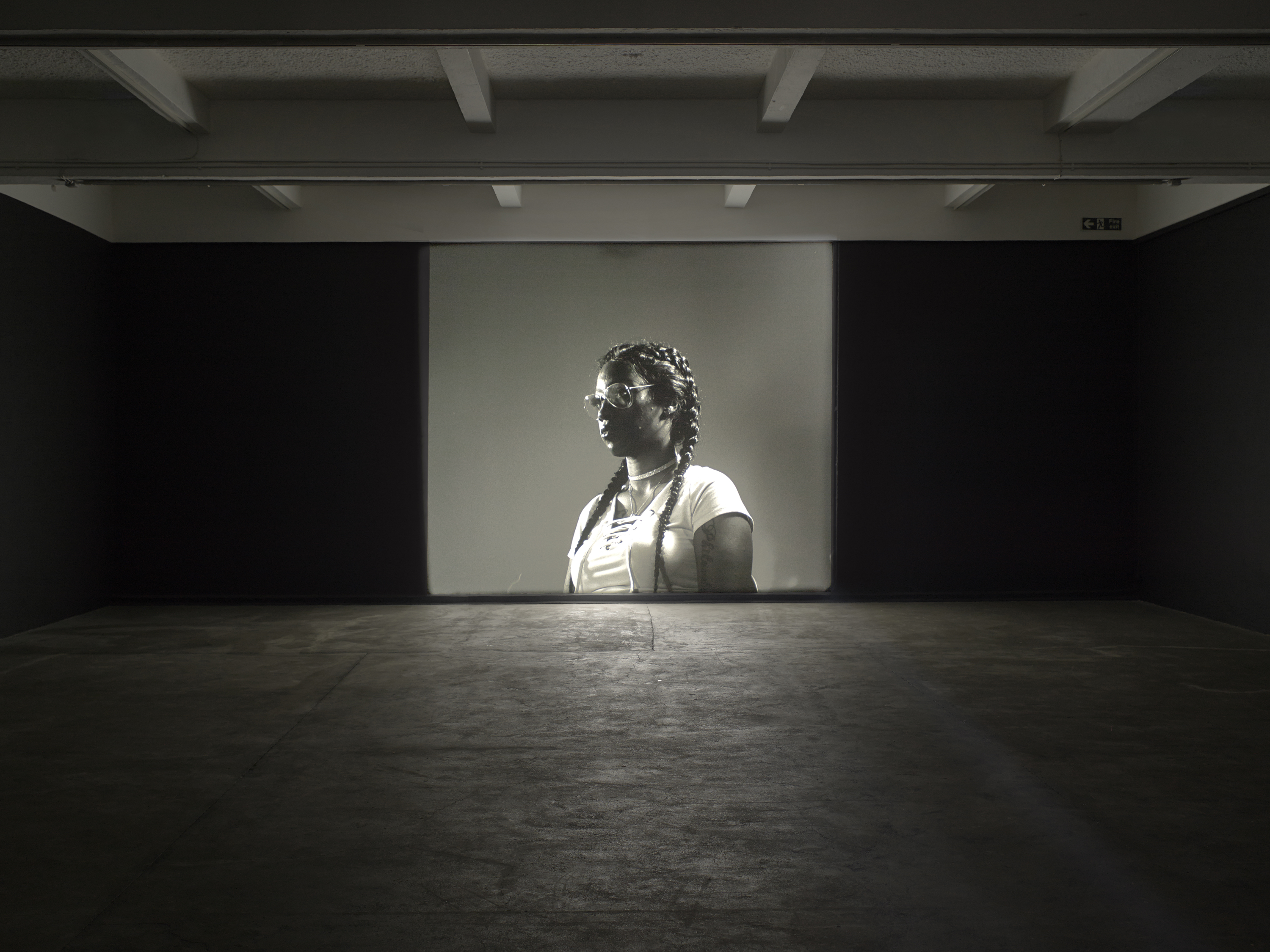Autoportrait.
Luke Willis Thompson
Chisenhale Gallery
Exhibition Review
Published Summer 2017.

© Image courtesy of Andy Keate.
The continuous mechanical chatter of a projector rattles like a generator, competing in intensity only with the rooms size and almost complete darkness. The black and white form of a female projected on the wall finishes a cycle, before looping back from the start. She seems young and troubled, the lack of colour feeding the solemnity in her face as she mouths answers to questions that remain unknown. This isn’t just any young woman; this is Diamond Reynolds, the widow of Philando Castile, whose case in a long list of what is largely accepted as police murders on young black american men, etched itself within the psyche of viewers worldwide by way of a Facebook Live video shot directly after her partners fatal shooting.
Anyone who has seen the video that Reynolds streamed, knows just how surreal the scene presented was. Such murders in America, occurring in a frighteningly quickening rate, of course seem horrific when explained via press conferences, carefully selected news-friendly images and opinion pieces written in their aftermath. Yet, this was something altogether more raw; we see Castile’s bloodied arm (that was shot seven times by then, 28 year old Jeronimo Yanez), we see the pistol still pointed at the wounded Castile and we hear Reynold’s commentary to her friends, family and strangers as she narrates the events that took place moments before, very aware that her partners life is slipping away.
Coined as the ‘sister-image’ to Reynolds’ video, the video installation in question entitled Autoportrait, was filmed by Luke Willis Thompson entirely on 35mm film in April 2017. Liaising with Reynold’s and her lawyer in late 2016, he proposed the idea of creating a reactionary installation regarding the murder. A native to Auckland, Thompson is no stranger to examining the social struggles, unrest and reactions within western societies, especially that concerning racial tension and violence. Alongside the production of Autoportrait during his 18 month residency with Chisenhale Gallery, he also created Cemetery of Uniforms and Liveries, a moving image portrait of two Londoners whose maternal relatives were the victims of police brutality. He was also commissioned by the New Museum Triennial to create an immersive performance that guided visitors away from the museum, taking them to places throughout New York that embodies racial tension within the city, and has also explored the themes of rioting in London both past and present, within his work.

Autoportrait, scene i. © Image courtesy of Andy Keate.
With this in mind, we can safely assume that Thompson’s decision to create such an installation is not only artistic or admirable but informed; enough to dismiss the almost glaring accusation of emotional or racial exploitation here. With the range, scope and preparation of his works, one can clearly see that the slant of his work is more than just filming people of colour, but giving them a space in which they can exist on their own terms, and allowing a story to be told without the bias of conventional media.
The lack of colour throughout is a strong move, removing the contexts of familiarity; of space and time. As the first scene of a spectacled Reynolds plays, it is her breathing that we begin to focus on; altogether tensed and controlled it makes the first half of the video anticipative of something that we aren’t altogether sure will be. She is given distance here from the camera and allowed to be observed without speech. Merging with the second scene, we are presented with an uncannily photographic crop. This frame, clearly the stronger of the two has us so intimate with Reynolds to the extent that we can take the entirety of her facade; impossibly long eyelashes that sitting above solemn eyes. Couplets of spots that sit on her cheeks. The ability to be so close with someone who has been through so much, does indeed feel like a gift that should not be taken for granted.
With all of this in mind, one can almost feel an excruciating frustration of not know what it is she is mouthing to the unseen interviewer, yet her silence throughout the video serves as a powerful parallel of the calm, brave dictation in the video she became famous for.
Overall Autoportrait’s success lies in its simplicity, in its respect and dedication to presenting an impartial, albeit it silent, narrative. The visual relationship between the two scenes does feel somewhat unnatural once observed a good handful of times (the latter outshining the former in sincerity, aesthetic and engagement) but this just strengthens the latter, leaving audiences asking more and more questions, imploring them to watch it one last time, for its fifth or sixth cycle.